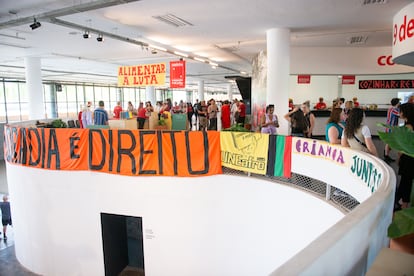Brazilian culture savors freedom after the hostility of the Bolsonaro years
The São Paulo Biennial embraces social movements and brings back a popular dance piece effectively banned during the previous far-right administration


The pandemic has left a clear trail on the streets of São Paulo, Latin America’s wealthiest city and the largest in the southern hemisphere, where homelessness and cranes have proliferated side by side. While a luxury apartment building is being built on every empty lot in the richest neighborhoods, the sidewalks are the only home for some 50,000 people, including families with children. This is the context in which the São Paulo Biennial, inaugurated last week, invited the Cozinha Ocupação 9 de Julho, a social activism project fighting for decent housing, to participate in the great Brazilian contemporary art event. This 35th edition has embraced a combative movement after a tough period for art and activism in Brazil due to the hostility of former president Jair Bolsonaro and his extreme right-wing government.
One of the most famous squats in São Paulo is located just a few miles from the elegant pavilion that Oscar Niemeyer created for the biennial, which runs until December 10 and hosts a restaurant featuring his dishes and acts as a showcase for his demands: that abandoned buildings and plots of land be used to guarantee the constitutional right to housing. For its promoters, collective cooking is part of the fight for food security and against hunger: 33 million Brazilians go to bed hungry. This is what happens every Sunday in this building in downtown São Paulo, which is also home to dozens of families.
“This is historic,” said a member of Cozinha Ocupação 9 de Julho, Katia Lyra, 42, as she finalized details before the inauguration. Alongside posters with slogans such as “cooking is revolutionary” and “domestic is political,” the banners of many other social movements that have regained visibility after the electoral victory of Luiz Inácio Lula da Silva can be seen.

This edition, entitled Choreographies of the Impossible, brings together 121 artists, 80% of who are non-white, with the aim of giving voice to the knowledge of the traditionally marginalized. The biennial “is a platform to raise questions instead of giving answers,” stressed Portuguese curator and artist Grada Kilomba at the inauguration. Brazilians Diane Lima and Hélio Menezes, along with Spaniard Manuel Borja-Villel, are the other curators of the 35th edition.
One of the big differences between the Brazilian Biennial and the Venice Biennial or Documenta Kassel is that the São Paulo exhibition is free, open to the entire public and with a popular vocation. Its organizers hope that spending some time there will become a weekend plan over the next three months.
The Brazilian cultural sector is breathing a sigh of relief, tasting freedom after a period in which an asphyxiating environment for artistic creation was instilled. Hand in hand with Bolsonaro, the extreme right, emboldened, placed artists very high on their list of enemies. Testing the limits entailed greater risk of being silenced than applauded. Censorship loomed over cultural programming in the form of sudden and poorly explained cancellations of events.
Recovery of Luiz Abreu’s montage
Among those were performances of the popular dance piece O samba do crioulo doido, which was subject to a series of cancellations in a climate of hostility and ultra-conservatism. The São Paulo Biennial has recovered it. It is a staging devised by choreographer Luiz Abreu that premiered almost 20 years ago as a critique of the eroticization of the Black body, racism, and colonialism. A video shows a dozen almost naked Black men and a woman — dressed only in thigh-high silver boots — sensually gyrating in front of a background of Brazilian flags, while the singer Elza Soares says: “The cheapest meat on the market is Black meat.”
The military dictatorship (1964-1985) that Bolsonaro pined for affected several editions of the biennial: 1969 is remembered as the Biennial of the Boycott because 80% of the invited artists refused to participate in protest against the AI5 decree that dissolved Congress and led to stricter repression. In Paris, a group of artists gathered at the Museum of Modern Art under the manifesto “Non à la Biennale.” There was also a protest in Brazil. The jury still awarded works by artists openly opposed to the regime.
Sign up for our weekly newsletter to get more English-language news coverage from EL PAÍS USA Edition
Tu suscripción se está usando en otro dispositivo
¿Quieres añadir otro usuario a tu suscripción?
Si continúas leyendo en este dispositivo, no se podrá leer en el otro.
FlechaTu suscripción se está usando en otro dispositivo y solo puedes acceder a EL PAÍS desde un dispositivo a la vez.
Si quieres compartir tu cuenta, cambia tu suscripción a la modalidad Premium, así podrás añadir otro usuario. Cada uno accederá con su propia cuenta de email, lo que os permitirá personalizar vuestra experiencia en EL PAÍS.
¿Tienes una suscripción de empresa? Accede aquí para contratar más cuentas.
En el caso de no saber quién está usando tu cuenta, te recomendamos cambiar tu contraseña aquí.
Si decides continuar compartiendo tu cuenta, este mensaje se mostrará en tu dispositivo y en el de la otra persona que está usando tu cuenta de forma indefinida, afectando a tu experiencia de lectura. Puedes consultar aquí los términos y condiciones de la suscripción digital.
More information
Archived In
Últimas noticias
Welcome to the post-religion era: The idea of Christianity as the absolute truth has become obsolete
‘I thought you would like it’: The risky sexual practice popularized by TV shows and TikTok
The digitalization of tourism: ‘They promise experiences and gave us the worst possible one’
Mexican peso defies uncertainty with forecasts of a new period of stability in 2026
Most viewed
- Sinaloa Cartel war is taking its toll on Los Chapitos
- Reinhard Genzel, Nobel laureate in physics: ‘One-minute videos will never give you the truth’
- Oona Chaplin: ‘I told James Cameron that I was living in a treehouse and starting a permaculture project with a friend’
- Why the price of coffee has skyrocketed: from Brazilian plantations to specialty coffee houses
- Silver prices are going crazy: This is what’s fueling the rally










































